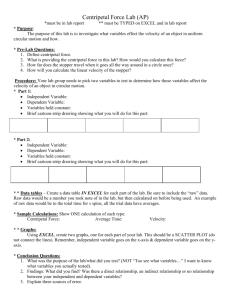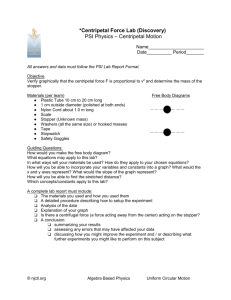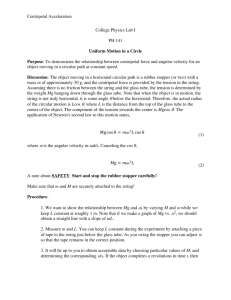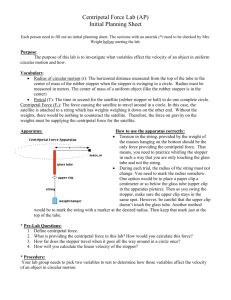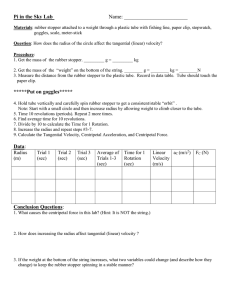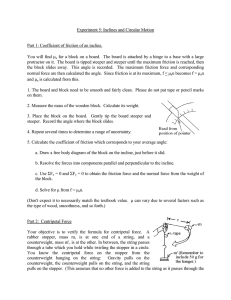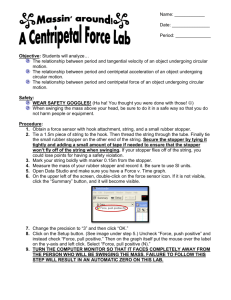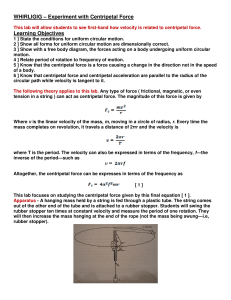Experiment 4: Motion in a Plane
advertisement
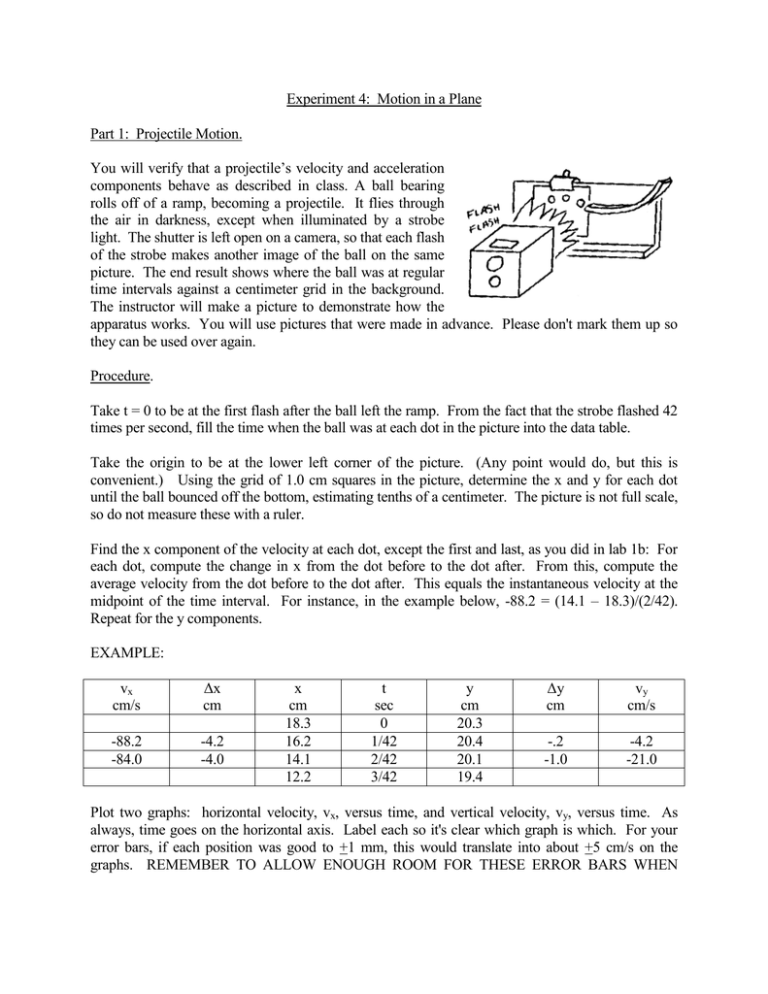
Experiment 4: Motion in a Plane Part 1: Projectile Motion. You will verify that a projectile’s velocity and acceleration components behave as described in class. A ball bearing rolls off of a ramp, becoming a projectile. It flies through the air in darkness, except when illuminated by a strobe light. The shutter is left open on a camera, so that each flash of the strobe makes another image of the ball on the same picture. The end result shows where the ball was at regular time intervals against a centimeter grid in the background. The instructor will make a picture to demonstrate how the apparatus works. You will use pictures that were made in advance. Please don't mark them up so they can be used over again. Procedure. Take t = 0 to be at the first flash after the ball left the ramp. From the fact that the strobe flashed 42 times per second, fill the time when the ball was at each dot in the picture into the data table. Take the origin to be at the lower left corner of the picture. (Any point would do, but this is convenient.) Using the grid of 1.0 cm squares in the picture, determine the x and y for each dot until the ball bounced off the bottom, estimating tenths of a centimeter. The picture is not full scale, so do not measure these with a ruler. Find the x component of the velocity at each dot, except the first and last, as you did in lab 1b: For each dot, compute the change in x from the dot before to the dot after. From this, compute the average velocity from the dot before to the dot after. This equals the instantaneous velocity at the midpoint of the time interval. For instance, in the example below, -88.2 = (14.1 – 18.3)/(2/42). Repeat for the y components. EXAMPLE: vx cm/s Δx cm -88.2 -84.0 -4.2 -4.0 x cm 18.3 16.2 14.1 12.2 t sec 0 1/42 2/42 3/42 y cm 20.3 20.4 20.1 19.4 Δy cm vy cm/s -.2 -1.0 -4.2 -21.0 Plot two graphs: horizontal velocity, vx, versus time, and vertical velocity, vy, versus time. As always, time goes on the horizontal axis. Label each so it's clear which graph is which. For your error bars, if each position was good to +1 mm, this would translate into about +5 cm/s on the graphs. REMEMBER TO ALLOW ENOUGH ROOM FOR THESE ERROR BARS WHEN SETTING UP YOUR GRAPHS: In particular, people tend to magnify the x graph too much. Also, remember the other rules for graphs given in the freefall lab. Before drawing lines on the graphs, answer these two questions: 1. How are the horizontal components of a projectile's velocity and acceleration supposed to behave? 2. How are the vertical components of a projectile's velocity and acceleration supposed to behave? Now see if you can fit a line through your data which is consistent with your answers. (Since the uncertainty is the range which the experimental errors are probably in, this line might miss a few of the error bars, but it should pass through most of them, and not miss the rest by much.) 3. Is your answer to (1) what your vx vs. t graph actually shows? 4. Is your answer to (2) what your vy vs. t graph actually shows? (The answers to questions 1 through 4 will be the “conclusion” part of your writeup.) Part 2: Centripetal Force Your objective is to verify the formula for centripetal force. A rubber stopper, mass m, is at one end of a string, and a counterweight, mass m', is at the other. In between, the string passes through a tube which you hold while twirling the stopper in a circle. You know the centripetal force on the stopper from the counterweight hanging on the string: Gravity pulls on the counterweight, the counterweight pulls on the string, and the string pulls on the stopper. (This assumes that no other force is added to the string as it passes through the tube.) You will separately find mv2/r to see if it matches the known force: You get m by putting the stopper on a balance. You get r by measuring the apparatus with a meter stick. You get v by counting the number of revolutions the stopper makes in a minute. Procedure: Use at least 150 grams for m'. Twirl the stopper in a horizontal circle above your head, at the right speed so that the string does not slip up or down through the tube. A piece of tape on the string, maybe half an inch below the tube, makes it easier to watch its movement. Do not interfere with free movement of the string: Touch only the tube, not the string itself, and do not let the tape touch the bottom of the tube. Because of friction, there will be a range of speeds where the tape stays put. Use the slowest speed where the tape does not begin to sink. It is also important that you move your hand in as small a circle as possible. Twirl it from the wrist, not the elbow. After some practice, count N, the number of revolutions the stopper makes in one minute. Then, lay the apparatus on the table with the same size gap between the tube and the tape, and measure r, the radius of the path of the stopper's center. Record the masses of the stopper, m, and the counterweight, m'. Calculations: In your calculations, have all distances in meters, mass in kilograms, and time in seconds. This will make force come out in newtons. Compute the stopper's speed: The distance covered during each revolution is the circumference of the circular path, 2πr. So, in N revolutions, the total distance covered is N(2πr). Speed is distance ÷ time; calculate the speed from the fact that the stopper covers this much distance in 60 sec. Compute the quantity mv2/r. Also, compute the weight of m', which equals the centripetal force. The value from the formula has a 20% uncertainty; the weight of the counterweight has an uncertainty which is quite small. If your two values do not agree, and you've made no mistakes in your calculations, then your twirler probably hasn't quite perfected his or her technique. Ask the instructor for suggestions, and double-check your data. Did you succeed in verifying that Fc = m v2/r? Experiment 4 - Motion in a Plane I. Projectile Motion. vx cm/s Δx cm x cm t sec y cm Δy cm vy cm/s _ _____________________________________________________________________________ _____________________________________________________________________________ _____________________________________________________________________________ _____________________________________________________________________________ _____________________________________________________________________________ _____________________________________________________________________________ _____________________________________________________________________________ _____________________________________________________________________________ _____________________________________________________________________________ _____________________________________________________________________________ (Attach two graphs.) II. Centripetal Force: m= Compute v of cork: mv2 = r m'g = m' = N= r=
